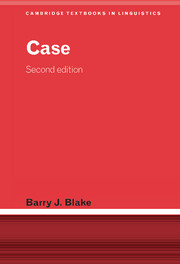Book contents
- Frontmatter
- Contents
- List of figures
- List of tables
- Preface to the Second Edition
- Preface to the First Edition
- List of abbreviations
- 1 Overview
- 2 Problems in describing case systems
- 3 Modern approaches to case
- 4 Distribution of case marking
- 5 Survey of case marking
- 6 Life cycle of case systems
- Notes
- Guide to terminology
- Guide to further reading
- References
- Author index
- Language index
- Subject index
Preface to the Second Edition
Published online by Cambridge University Press: 05 June 2012
- Frontmatter
- Contents
- List of figures
- List of tables
- Preface to the Second Edition
- Preface to the First Edition
- List of abbreviations
- 1 Overview
- 2 Problems in describing case systems
- 3 Modern approaches to case
- 4 Distribution of case marking
- 5 Survey of case marking
- 6 Life cycle of case systems
- Notes
- Guide to terminology
- Guide to further reading
- References
- Author index
- Language index
- Subject index
Summary
About seven years have passed since I wrote the first edition of Case. It is now time to review what I wrote then and to take account of recent publications in the field. This second edition incorporates a number of significant additions to the data and some revised interpretations of data. It also incorporates a number of improvements and expansions to the discussion of important concepts, taking into account current developments in the field. As in the first edition, I have paid particular attention to traditional and current notions and terminology, not just in case itself, but in the areas of word class, structure, agreement, roles and grammatical relations.
The most substantial revision has been to section 3.3, which deals with abstract case in the Chomskian paradigm. I have updated this section, not without some difficulty. The book as a whole is aimed at students and academics in general linguistics or in languages, but the Chomskian paradigm contains numerous concepts and terms peculiar to itself. Introducing too many of these notions in a short section can lead to obscurity, but introducing too few runs the risk of distortion. Moreover, different authors within the paradigm adopt different approaches and the model is forever changing. Interested readers can follow up the references given in note 4 to chapter 3.
- Type
- Chapter
- Information
- Case , pp. xiii - xivPublisher: Cambridge University PressPrint publication year: 2001

